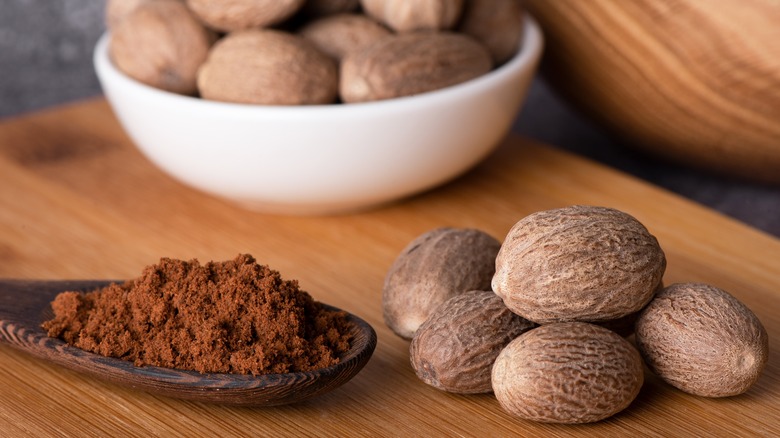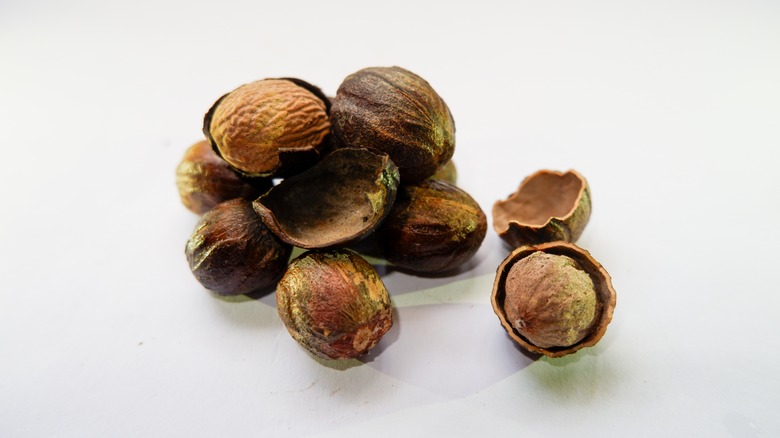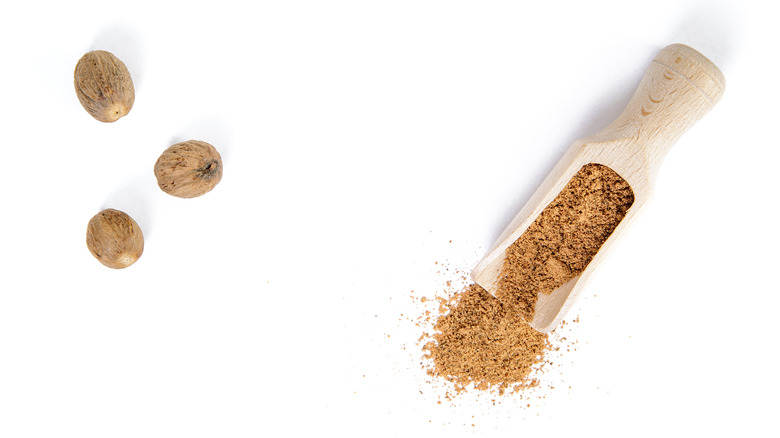How Much Nutmeg Does It Take To Cause Hallucinations?
If there's one thing human beings excel at, it's finding new ways to get intoxicated. Our relentless quest to escape the woes of reality has led us to some unexpected places, including our pantries. The thought of getting high on one's food supply has a particular appeal because, unlike most drugs, food is legal (and it's safe to assume it will stay that way), but it seldom yields results. It turns out your local Kroger store isn't a very good plug. Most of the food-drug scandals you hear about are complete hoaxes, like injecting peanut butter and mayonnaise, but there is something in your spice cabinet that can actually make you hallucinate: the seeds of a certain Indonesian evergreen tree commonly known as nutmeg. If this knowledge tempts you, you'd better pump your breaks. Nutmeg-induced hallucinations are more dangerous than you'd think, but thankfully, it takes way more than any recipe would call for.
This is your brain on nutmeg
The key to nutmeg's hallucinogenic effects lies in a chemical called myristicin, named after Myristica fragrans, the scientific name for the nutmeg tree. Myristicin affects the central nervous system (CNS) in ways that closely mimic familiar recreational drugs. Many report feeling effects similar to those of cannabis, which is backed by research suggesting that myristicin interacts with the human endocannabinoid system. That's only the tip of the iceberg, though, as myristicin also mimics mescaline, the active compound in peyote. Both chemicals trigger the release of norephedrine in the CNS. On top of that, many scientists believe that myristicin metabolizes into an amphetamine called MMDA, which, as you've probably guessed by the name, is closely related to MDMA.
We understand that these comparisons may sound appealing to some, but there's a reason that nutmeg isn't nearly as popular as those aforementioned drugs, despite its legality and accessibility. Myristicin is powerfully anxiogenic, meaning it causes severe anxiety. People who ingest nutmeg to get high consistently report feelings of extreme fear and impending doom. This is exacerbated by significant physical discomfort. Myristicin raises heart rate and blood pressure, causing palpitations and hypertension. Nausea, dizziness, and blurry vision are common side effects. These unpleasant symptoms can last as long as two days. Though not generally considered deadly, two reported cases of fatal nutmeg overdoses have been reported. The first was an 8-year-old child in the early 1900s, and the second was a 55-year-old woman in the early 2000s.
Hallucinating takes a lot of nutmeg
After reading that last paragraph, you might feel like dumping all your nutmeg down the drain, but if you're using it for culinary purposes, you have no reason to worry. It takes at least five grams (just over two teaspoons) of powdered nutmeg to present any intoxicating effects, and it typically takes 10-15 grams to cause severe hallucinations. Things get dangerous when you approach the 50-gram mark, evidenced by the notable case of an 18-year-old girl committed to a hospital after drinking three-quarters of a milkshake laced with 50 grams of nutmeg. The odds of you accidentally ingesting an intoxicating amount of nutmeg are next to nil, considering that most recipes call for between ¼ and ½ teaspoons of the spice, which would amount to even less per serving.
Nutmeg overdoses are a much bigger problem for children. The 8-year-old who died from it consumed 14 grams, right around the hallucinogenic threshold for adults. This is why people got so concerned in the spring of 2020 when the viral "nutmeg challenge" took over TikTok. Like the infamous cinnamon challenge, the nutmeg challenge entails eating dangerously large amounts of nutmeg (typically 2-4 tablespoons) and recording one's response. Facing severe backlash, TikTok began taking down any posts promoting the nutmeg challenge. However, reports of teenage TikTokers being admitted to emergency rooms for nutmeg poisoning continued into 2022, and, like many social media trends, it could resurface elsewhere if people aren't better educated on the potential danger.


